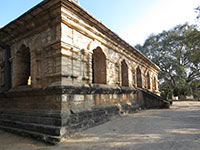Traditionally ascribed to King Keerthi Sri Rajasinghe, it is said that while this building was being completed the king heard of the discovery of a cave at Degaldoruwa and stopped the work on Galmaduwa shifting his attention to Degaldoruwa. Sadly, in its unfinished state, this building was never used as a temple.
The Galmaduwa viharaya is an impressive building of strange architecture. As its local name suggests, it is basically a pavilion built of stone and brick. But a high gopuram gives it a Hindu identity. There is an ad mixture of Tamil-Hindu influence within the Buddhist place of worship.
The Galmaduwa viharaya is an impressive building of strange architecture. As its local name suggests, it is basically a pavilion built of stone and brick. But a high gopuram gives it a Hindu identity. There is an ad mixture of Tamil-Hindu influence within the Buddhist place of worship.
J.P Lewis, says that the “Galmaduwa Viharaya probably enjoys the unique distinction of being the most Hindu-looking Buddhist temple in existence”
Describing its architectural features he says : “The central building is surrounded by a massive wall with an overhanging and deeply molded cornice, the outer wall is pierced on three sides by five windows; on the fourth, which is on the west side, the place of the central window is taken by a doorway of slightly larger dimensions. The distance between the central building and the outer wall according to rough measurement is 14 feet. The former is 29 feet, the latter 16 feet square. There are but two doorways, one into the enclosure and one opposite it into the sanctum. They are each 6 feet wide, the windows 4 1/2 feet. The thickness of the outer wall is 3 ¼ feet, not including the moldings of the wall of the sanctum 3 feet.
According to Lewis “The most interesting feature about this building is the shape of the arches of the doorways and the windows. They are semi circular cusped arches with a keystone.
The door at the entrance to the enclosure has six of these cusps; the widows two only.
The door of the viharaya had also only two cusps, but the apex is formed of an ogee arch. There is a massive stone border or framing around the windows around the exterior and this framing includes the arch, the outer line of which is simply semi circular.
“The sanctum is furnished in the interior with the asane, the pedestal or throne for the image , but otherwise is quite bare.
The brick domed roof is un-plastered. Immediately at the back of the outer wall of the building erected on the eastern side and within six feet of it, is a small vihara built by the the villagers some 125 years ago in lieu of the imposing structure never to be completed.
They erected this building because they were unable to raise the unfinished main temple. The mean work of the more modern plastered building consorts ill with the massive stone and brick masonry of the of the original but unfinished temple.”
 |
 |
 |
 |
 |
 |
 |
 |
 |
 |
 |
 |
Source :amazinglanka
No comments:
Post a Comment